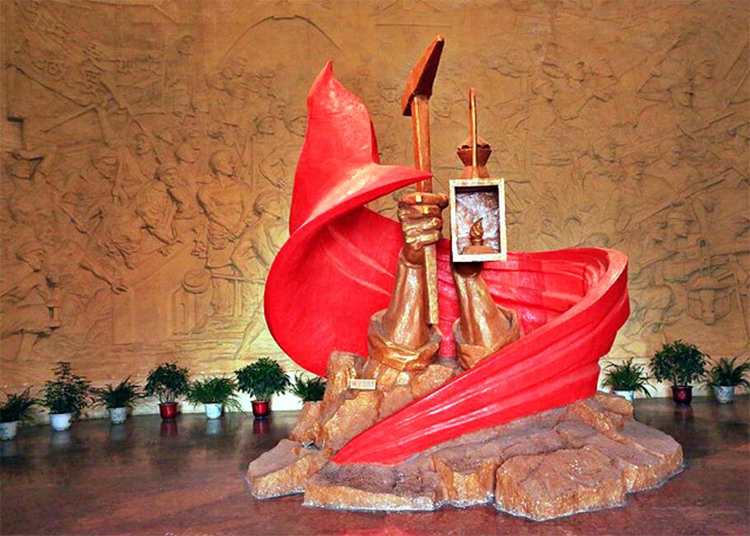Red Tourism at Yuanshuiyuan: Stroll Through Revolutionary Heritage and Scenic Wetlands
Introduction
Nestled among the green hills and clear waters of Pingxiang, Jiangxi, Yuanshuiyuan Red Culture Park preserves both the sparks of China’s revolutionary past and a nationally recognized wetland sanctuary. Walk its boardwalks and you’ll see sculptural groups emerging from morning mist, hear reeds whispering along the Yuan Shui River, and feel the echo of an era when a ‘‘single spark could start a prairie fire.’’ This unique fusion of red heritage and living ecology makes the park a three-dimensional primer on the Autumn Harvest Uprising and Jiangxi’s landscapes.
1. Soul Imprint: The Double Solo of Red Heritage and Ecological Scenery
Yuanshuiyuan frames a century of history through a single-park lens, marrying the 1927 Autumn Harvest Uprising memories with 21st-century ecological design. Think of it as an open-air revolutionary museum set within a national wetland park — an official patriotism education base and a secret sunrise spot for photographers.
Three must-do experiences:
– Historical immersion: Follow the route of Mao Zedong’s forces to the riverside decision site and relive the tense moments of strategic planning at Luxi.
– Ecological therapy: Stroll the 6-km waterfront boardwalk and spot egrets and other wetland wildlife in their natural refuge.
– Interactive learning: Try on Red Army straw shoes and join simple farm tasks to appreciate the hardships behind ‘‘millet and rifles.’’
2. Historical Site: The Luxi Chapter of the Autumn Harvest Uprising
In September 1927, Mao and his troops rested and made critical decisions here. The former temporary command post still preserves original wooden doors and maps. The park brings history alive through three main scenes:
– Time Corridor: Over 200 uprising artifacts — from rusted bugles to handwritten slogans — are displayed and augmented with AR reconstructions of key battles.
– Wall of Lives: A black basalt memorial carved with the names of 327 martyrs from Luxi.
– Immersive Theater: A daily 14:00 live performance, “Sparks at Luxi,” reenacts events; actors invite the audience to join in singing the revolution-era song “Workers, Peasants, and Soldiers Unite.”
3. Architecture and Landscape: Where Revolutionary Aesthetics Meet Gan-style Ecology
As you wander, three visual languages intertwine:
– Red memory symbols: A giant pentagram plaza in weathered steel and a memorial hall shaped like a traditional cave dwelling.
– Gan-style elements: Study-base courtyards built with blue bricks and dark tiles, featuring interior wells that showcase the local ‘‘four waters converging’’ in rainy weather.
– Wetland ecological art: A glass viewing platform over the Yuan Shui River overlooks a reed maze arranged to resemble a “revolutionary torch” from above.
Photography tips:
– Shoot silhouettes of the sculptures in morning mist from Spark Tower at sunrise.
– In autumn evenings, capture the contrast of golden rice paddies and red flags in the Rice Aroma Experience Area.

4. Deep Experiences: From Red Army Stove to Nature Classroom
The park offers tactile ways to learn revolutionary history:
– Red Kitchen: Cook pumpkin soup and red rice over a wood fire to experience Red Army rations (reserve two hours in advance).
– Radio Decoding: Families can complete intelligence-transmission missions using Morse code devices.
– Wetland Birdwatching: From October to December the park supplies binoculars for wintering bird observation.
Local hidden tip:
Pick up the “Trace-seeker Handbook” at the visitor center. Collect five hidden stamps and exchange them for a handmade bamboo Red Army hat.
5. Practical Guide: Be a Well-Prepared Time Traveler
Opening hours:
– Park open year-round, 09:00–17:00 (last entry 16:30).
– Night light shows run 19:30–21:00 on legal public holidays.
Getting there:
– Take tourist line 666 from Pingxiang North Station (about 40 minutes).
– Drivers should navigate to “Yuanshuiyuan East Parking.” Free EV charging is available for two hours.
Costs:
– Basic admission is free; immersive theater costs ¥80 per person.
– Red Army-style meals range ¥30–50 per person (try bamboo-steamed cured pork).
Tips for international visitors:
– Major exhibits offer English and Chinese audio guides for rent (¥20 each).
– WeChat covers about 90% of payments, but bring ¥200 cash for rural market purchases.

Conclusion
When the setting sun gilds the Autumn Harvest sculptures, you’ll feel that Yuanshuiyuan is more than a historical coordinate — it’s a century-long conversation. Whether tracing bullet-marked bricks or watching a dragonfly skim a boardwalk, the park tells the intertwined stories of revolutionary spirit and living nature. Add it to your western Jiangxi itinerary; this red land waits to unfold a uniquely Chinese story for you.


